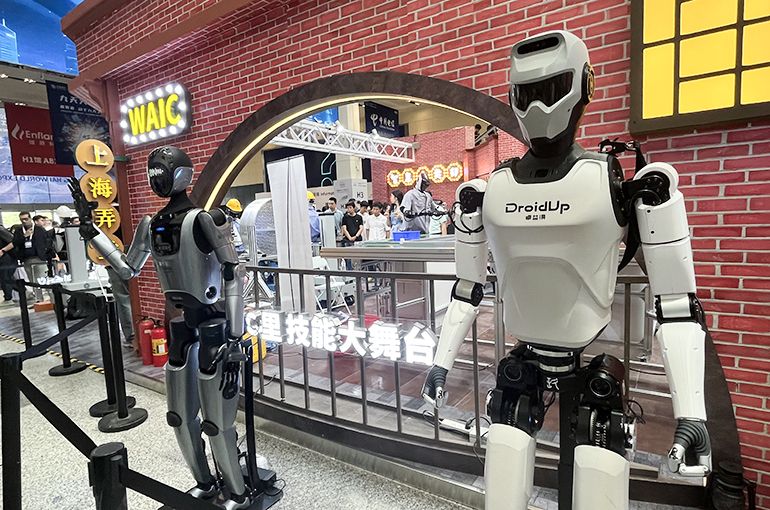The humanoid robot sector continues to make headlines as a beacon of technological innovation, yet, as of mid 2025, it still awaits its defining breakthrough a moment akin to Apple’s revolutionary iPhone launch in 2007. Zhang Zhengyou, head of Tencent’s Robotics X Lab, highlighted this sentiment during the recent World Artificial Intelligence Conference (WAIC) in Shanghai.
He emphasized that despite advancements in robotics, the field of embodied intelligence is still far from delivering a widely adopted consumer grade product. We’re not even at the brick phone stage yet, Zhang remarked, comparing the state of humanoid robotics to the primitive mobile phones that preceded the smartphone boom.
This analogy speaks volumes the sector is bubbling with innovation, but real world application, affordability, and scalability remain hurdles. In this article, we examine why the humanoid robot sector hasn’t hit its iPhone moment and explore the technological, commercial, and psychological barriers standing in the way.
The Humanoid Robot Sector: Evolution Without Revolution
The Technological Landscape
The last decade has seen immense progress in artificial intelligence, machine learning, and robotics hardware. Companies like Tesla, Boston Dynamics, and Xiaomi are investing heavily in humanoid robot sector research, unveiling prototypes that walk, talk, and interact with humans in sophisticated ways. Yet most of these remain lab bound or available only in niche B2B use cases.
Tesla’s Optimus robot was launched with great fanfare in 2022, promising household support, but it still hasn’t reached the average consumer’s home. Its application is mostly internal within Tesla’s factories.
Unlike the smartphone industry, which benefitted from existing infrastructure and high consumer demand, humanoid robots face a more complex value chain balancing AI precision, motor coordination, cost effective manufacturing, and trust in human robot interaction.
Commercial Limitations
While billions are poured into R&D, actual monetization is slow. Unlike smartphones or wearables, robots come with higher costs, lower margins, and more ambiguous use cases. According to a 2025 McKinsey report, the humanoid robotics market may be worth over $50 billion by 2030, but most of that value is still tied to industrial or medical applications not home assistants or companions.
Why the iPhone Moment Is Still Distant
Zhang Zhengyou of Tencent isn’t alone in his perspective. Experts across the field echo similar concerns. Dr. Cynthia Breazeal, a robotics pioneer from MIT, told IEEE Spectrum. Humanoid robots are fascinating, but until they can solve a problem more affordably and efficiently than existing tools, they won’t go mainstream.
This “usefulness gap” is key. For example, why would someone spend $15,000 on a home robot to fetch coffee when a $5 smart speaker sets a reminder to get it yourself? Moreover, regulatory red tape and ethical concerns around robot autonomy, surveillance, and safety are also delaying full scale deployment.
A Glimpse into the Present
Ali Hussain, a Pakistani entrepreneur and early adopter of robotics in retail, shared his experience deploying humanoid robots at his store chain. We brought in a Japanese humanoid for customer service, Ali explained. It attracted footfall for the first few months, but soon we realized people were just curious.
The robot wasn’t intuitive enough. It couldn’t understand regional dialects or cultural cues. Ali’s story is a microcosm of the humanoid robot sector today exciting, experimental, but not yet essential. High novelty, low retention.
What Needs to Change?
1. Unified Platform Ecosystem
Just like the iPhone thrived because of its app ecosystem, humanoid robots need a universal platform that encourages third party development and integration. Today, robot operating systems are fragmented, limiting synergy.
2. Affordability
Bringing down production costs and offering financing or leasing models could make humanoid robots more accessible. Xiaomi recently hinted at a $3,000 consumer model, which, while cheaper than its competitors, is still beyond mass market affordability.
3. Emotional Intelligence
The most powerful smartphones aren’t just smart they’re intuitive. To trigger the humanoid robot sector’s iPhone moment, robots need to read human emotions, adapt, and form real connections. Advances in Natural Language Processing (NLP) and affective computing are steps in the right direction but remain incomplete.
The Path to the ‘iPhone Moment’
The moment that changes everything will likely come not when a robot can walk better or hold a tray steadier, but when it becomes indispensable. A true revolution will occur when humanoid robots transition from “cool gadgets” to everyday essentials. As Zhang Zhengyou concluded at WAIC. Once we solve the interface between emotion, intent, and action then the iPhone moment will come. And it will come fast.
In summary, the humanoid robot sector is at a thrilling yet frustrating juncture. The pieces are on the table, but the puzzle isn’t complete. Until there’s a product that fuses design, function, emotion, and value into a single package just like the iPhone did the dream of every home having a humanoid robot remains a vision of the future.
The humanoid robot sector is not short on innovation it’s short on application. The iPhone moment will require not just technical brilliance, but emotional resonance and societal acceptance. Until then, the humanoid robot remains a brilliant prototype, waiting for its stage.

